Apr 13, 2025
Apr 13, 2025
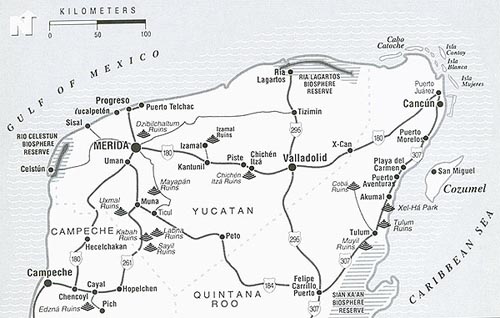
In an attempt to explore the historic lands of the Maya, we landed in Cancun which is probably the quickest and easiest way to get into this part of Mexico. Cancun of course is a party town, crass and commercial, and caters to the needs of the free spirit. We set base in Cancun, which is slowly limping back to life after the wrath of Hurricane Wilma and proceeded to the somewhat laid back town of Playa Del Carmen, a short drive on Hwy 307. A quick trip to the sandy beach followed by a leisurely stroll on Fifth Avenue which is closed to traffic, offered us ample opportunities to take in the sights and sounds of this beautiful town. The multitude of small shops selling trinkets and handicrafts is enough to keep you hopping as you mingle with the locals and practice your limited vocabulary of Espanol, although most of the shopkeepers speak reasonably good English. Around dusk, the place takes on a festive atmosphere with music and lights.
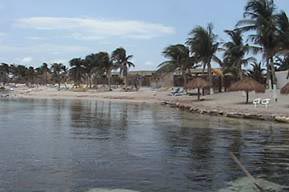 The next day we hopped on a ferry to Isla Mujeres, the island of women on the Caribbean Sea, a few nautical miles from Cancun. The beaches here are much more pristine and the island was infested with buccaneers and pirates once upon a time. The highlight of the day was 'snorkeling' in the coral reefs of the Caribbean, part of the El Garrafon ecological parks and it was absolutely awesome to see the coral reefs and swim with the large variety of splendidly colored fishes. Having done some of the things that a typical tourist to Cancun would, we set off on the toll highway 180 to Chichen Itza, one of the most well known Mayan ruins. The toll highway is the best way to get there by car and the maximum speed limit is 110km/hr (65mph). While the roads are well maintained, there are no exits, rest areas or gas stations for miles. However the toll stop offers some respite.
The next day we hopped on a ferry to Isla Mujeres, the island of women on the Caribbean Sea, a few nautical miles from Cancun. The beaches here are much more pristine and the island was infested with buccaneers and pirates once upon a time. The highlight of the day was 'snorkeling' in the coral reefs of the Caribbean, part of the El Garrafon ecological parks and it was absolutely awesome to see the coral reefs and swim with the large variety of splendidly colored fishes. Having done some of the things that a typical tourist to Cancun would, we set off on the toll highway 180 to Chichen Itza, one of the most well known Mayan ruins. The toll highway is the best way to get there by car and the maximum speed limit is 110km/hr (65mph). While the roads are well maintained, there are no exits, rest areas or gas stations for miles. However the toll stop offers some respite.
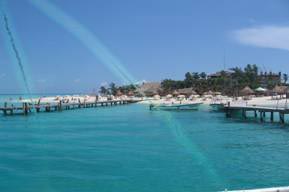 Chichen Itza was founded at the height of Mayan civilization during the golden Classic era circa 25-950 AD. Abandoned and forgotten for centuries after the Spanish invasion, the ruins were first discovered in the early 19th century by Stephens and Catherwood. The illustrations of the gifted Catherwood in the Lost Cities of the Maya are so lifelike, that it reminds one of a scene from Kipling's Jungle Book. Upon arriving at the site, the sheer beauty and magnificence of the El Castillo is too awesome to describe in words. Also known as the Pyramid of Kukulcan, the wind god, this pyramid that appears to touch the heavens is not only awe inspiring, but has a deeper significance.
Chichen Itza was founded at the height of Mayan civilization during the golden Classic era circa 25-950 AD. Abandoned and forgotten for centuries after the Spanish invasion, the ruins were first discovered in the early 19th century by Stephens and Catherwood. The illustrations of the gifted Catherwood in the Lost Cities of the Maya are so lifelike, that it reminds one of a scene from Kipling's Jungle Book. Upon arriving at the site, the sheer beauty and magnificence of the El Castillo is too awesome to describe in words. Also known as the Pyramid of Kukulcan, the wind god, this pyramid that appears to touch the heavens is not only awe inspiring, but has a deeper significance.
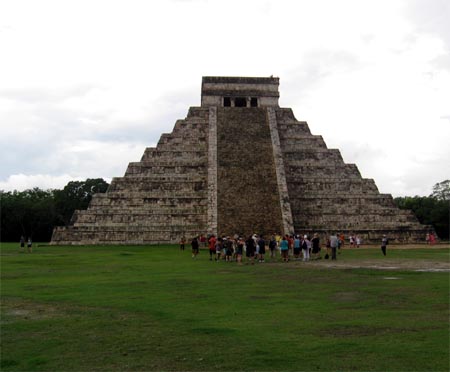
The precision of the architectural grandiose meant that it was used as a marker of time and seasons. During the spring and fall equinoxes, the sun enters the top of the pyramid and slithers down the western steps much like a snake would. The bottom of the pyramid shows the carving of a snake head with its mouth open and this represents Quetzalcoatl, the feathered serpent. The four sides of the pyramid represent the four directions and contain ninety one steps each. Adding the topmost base to the steps of the four sides gives it a grand total of 365, which is the total number of days in a year. This alone should tell us how advanced the Mayans were!
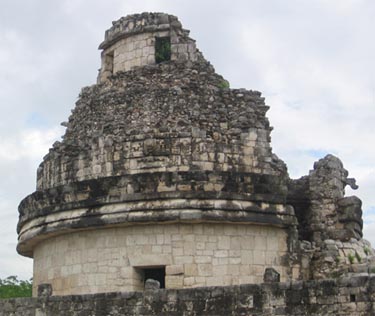
Another significance of the pyramid is that during the summer and winter solstices, the sun falls on top of the pyramid in such a way that it illuminates only two sides, attesting to the advanced architectural, engineering and astronomical knowledge of the Mayans. It was a little disappointing to learn from our guide that going up the steps is no longer allowed, as this has led to erosion and weathering over the years.
As we headed to the ballcourt, it was amazing to imagine yourself during a ball game very much like soccer that was played by the Mayans who dressed themselves in full gear and had to hit the ball through a ring on top of the walls. The losing team ended up being decapitated as illustrated by the carvings on the walls. The game was watched by the residents of Chichen including the high priest and other priests from the neighboring cities like Uxmal, Tulum, Coba.
One of the mysteries surrounding the Maya is that if they were so advanced and civilized, then how come they also entertained themselves in barbaric rituals. A general theory is that during the later Classic period, with the advent of the Toltecs, the act of violence became commonplace. The Toltec influence can be seen all over Chichen mainly in the form of the feathered serpent, Quetzalcoatl and the Chac-Mool, which is depicted as a crouched human figure with a flat belly on which sacrifices were offered.
The Mayans worshipped the natural elements and named these gods, much as in Indian mythology. One cannot help but wonder how these gigantic structures were built using just manpower in such precise alignments! As we marveled at the chamber of thousand pillars and other monuments, the one worthy of mention is the Observatory. The Mayans were no doubt great astronomers and skywatchers and followed the movement of Venus with great interest. In fact, the last Venus transit that occurred in June 2004 and the next one slated for June 2012 were both predicted by the Mayans several centuries ago. They used symbols for counting and were adept at the use of large numbers using a vigesimal system. Their calendar based on a total of 20 days per month for a total of 18 months per year (5 days were considered rest days) is known as the Haab. Truly, the Mayans were one with nature and cosmology was central to their lives.
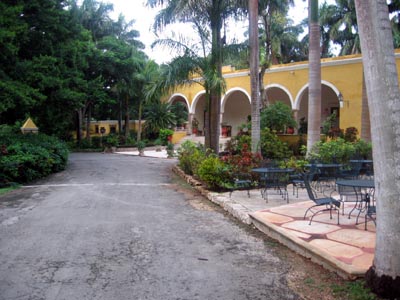 Walking away from all this magnificence, it was now time for a little R&R at the Hacienda Chichen, which needs special mention as not just another hotel, but an extraordinary place nestled in the woods next to the ruins, and for all its grandeur, it is a tranquil place. The Hacienda was built in the 16th century by the Spaniards that was eventually used as a place for the archaeologists from the Carnegie Institute to stay and do their excavations. Apart from the wide variety of flora and fauna, this is also a haven for the bird enthusiast. It was somewhat difficult to part from Chichen Itza, this hallowed grounds of a great civilization long gone.
Walking away from all this magnificence, it was now time for a little R&R at the Hacienda Chichen, which needs special mention as not just another hotel, but an extraordinary place nestled in the woods next to the ruins, and for all its grandeur, it is a tranquil place. The Hacienda was built in the 16th century by the Spaniards that was eventually used as a place for the archaeologists from the Carnegie Institute to stay and do their excavations. Apart from the wide variety of flora and fauna, this is also a haven for the bird enthusiast. It was somewhat difficult to part from Chichen Itza, this hallowed grounds of a great civilization long gone.
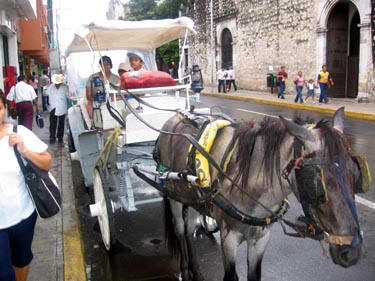 We got back on the toll highway 180 west bound towards Merida, the capital of Yucatan State. Once you reach Merida, it takes a while to get used to this rather rustic yet beautiful city with its cobblestone roads that are not named, but numbered. The N-S streets are even numbered while the E-W streets are odd numbered. Once you get used to this, then it is easier to figure out where Calle 60 x Calle 57 is located. Getting around Merida is easier by foot than by car and most of the activities are centered around Calle 60, the main thoroughfare in downtown. A colonial city, the people of Merida are extremely warm and courteous and indeed offer service with a smile. Walking around the Main Plaza, you can visit the Palacio de Gobierno and marvel at the huge murals depicting the struggles of the Mayan people against their rulers, see the 16th century Cathedral that is gigantic and yet blissful inside, stroll the park and watch the musicians playing. Driving along the Paseo Montejo's plush neighborhood, you get to the Museo de Antropologia which houses a number of Mayan artifacts including some rare excavations. Life in Merida begins after sunset as weary workers come to relax and enjoy the arts and culture that this wonderful city has to offer. Since there were so many shows scheduled simultaneously for that evening, we finally ended up going to the Teatro Peon Contreras, which is an almost 100 year old opera house that is absolutely majestic.
We got back on the toll highway 180 west bound towards Merida, the capital of Yucatan State. Once you reach Merida, it takes a while to get used to this rather rustic yet beautiful city with its cobblestone roads that are not named, but numbered. The N-S streets are even numbered while the E-W streets are odd numbered. Once you get used to this, then it is easier to figure out where Calle 60 x Calle 57 is located. Getting around Merida is easier by foot than by car and most of the activities are centered around Calle 60, the main thoroughfare in downtown. A colonial city, the people of Merida are extremely warm and courteous and indeed offer service with a smile. Walking around the Main Plaza, you can visit the Palacio de Gobierno and marvel at the huge murals depicting the struggles of the Mayan people against their rulers, see the 16th century Cathedral that is gigantic and yet blissful inside, stroll the park and watch the musicians playing. Driving along the Paseo Montejo's plush neighborhood, you get to the Museo de Antropologia which houses a number of Mayan artifacts including some rare excavations. Life in Merida begins after sunset as weary workers come to relax and enjoy the arts and culture that this wonderful city has to offer. Since there were so many shows scheduled simultaneously for that evening, we finally ended up going to the Teatro Peon Contreras, which is an almost 100 year old opera house that is absolutely majestic.
Estempas Mexicanas was a great performance featuring young regional dancers who performed traditional dances from Yucatan and Chiapas.
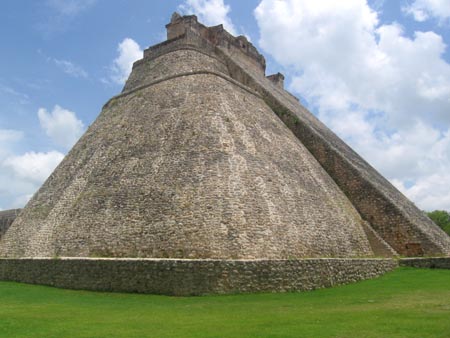
The following day, we headed south on 261 to Uxmal, another Mayan site that was also built during the heydays. The architecture is in the Puuc style and while there are several sites close by such as Kabah, Sayil and Labna, the grandest of them all is Uxmal. The symmetry and the architecture is breathtaking and is a feast for the eyes. The Pyramid of the Magician stands tall at 100 feet and behind it is the Nunnery Quadrangle which is quite a marvel.
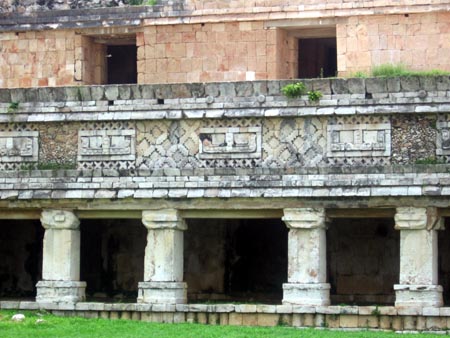
Trekking by the ballcourt, similar but smaller than the one at Chichen, we went past the House of Turtles and the Governor's Palace towards the Great Pyramid. Here we were allowed to go up the steps of the Great Pyramid which did not seem like a difficult task. The view from the top was magnificent as you could see the other structures, all in the middle of dense and lush green forests. Now coming down the steps was another story. There were no rails or any ropes to hold on to, the steps were extremely narrow, designed for small Mayan feet and the incline was stupendous, a sure case for vertigo! But it was fun nonetheless. The trip to Uxmal was worth it. Finally we bid adieu to yet another majestic landmark, made timeless by the creative minds of an amazing civilization, and headed back to the hubbub of Cancun.
09-Jul-2006
More by : Subra Narayan

|
Excellent narration.You do have a flair for writing Subra. |